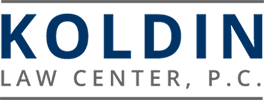What can my Spouse Keep?
This edition of the Koldin Report E-Newsletter is part of a series on Frequently Asked Questions About Medicaid.
All prior newsletters are saved on our website. You can read them by clicking here.
In this newsletter we answer the following question:
If I am in a Nursing Home, how much of our life savings can my spouse keep?
If you are in a nursing home, the Medicaid Agency takes a snapshot of the combined life savings of both you and your spouse as of the date you entered the Nursing Home. It doesn’t matter if your assets are joint or in separate names. Everything is counted as part of this snapshot.
As a nursing home resident, you are entitled to keep $15,450 of your combined life savings (2019 figures).
Your spouse living at home (Community Spouse) is entitled to keep your family home, one automobile, and one-half (½) of your combined life savings, but not less than $74,820 and not more than $126,420.
Example 1: Peter is in a nursing home. His wife, Mary, is living at home. On the day Peter entered a nursing home, they had combined life savings, not counting their home and automobile, of $200,000. Peter can keep $15,450. Mary can keep one-half (½) of $200,000 for a total of $100,000. The balance of their life savings of $84,550 must be spent on Peter’s care before he can qualify for Medicaid.
Example 2: Peter is in a nursing home. His wife, Mary, is living at home. On the day Peter entered a nursing home, they had combined life savings, not counting their home and automobile, of $300,000. Peter can keep $15,450. One-half (½) of $300,000 is $150,000, but this exceeds the cap of $126,420. So, Mary can keep $126,420. The balance of their life savings of $158,130 must be spent on Peter’s care before he can qualify for Medicaid.
Example 3: Peter is in a nursing home. His wife, Mary, is living at home. On the day Peter entered a nursing home, they had combined life savings, not counting their home and automobile, of $100,000. Peter can keep $15,450. One-half (½) of $100,000 is $50,000, but this less than the minimum of $74,820. So, Mary can keep $74,820. The balance of their life savings of $9,730 must be spent on Peter’s care before he can qualify for Medicaid.
Example 4: Peter is in a nursing home. His wife, Mary, is living at home. On the day Peter entered a nursing home, they had combined life savings, not counting their home and automobile, of $75,000. Peter can keep $15,450. After deducting Peter’s $15,450, they have $59,550 left. Since this is below the $74,820 minimum, Mary can keep $59,550. None of their life savings needs to be spent on Peter’s care before he can qualify for Medicaid.
These figures are the basic Medicaid eligibility rules. There are many options to protect assets that would otherwise need to be spent towards the cost of care.
If you are able to plan in advance, an Irrevocable Trust or Long Term Care Insurance should be considered.
For a discussion about Irrevocable Trusts, please visit our website by clicking here.
If you are already ill, even if you are already in a nursing home, there are asset protection options available.
The biggest mistake people make is assuming it is too late to protect some or all of your life savings. You have options to protect your life savings. However, once you spend your life savings towards nursing home costs, there is no way to get the money back.
For a discussion about how to protect your life savings even if you are already in a nursing home, please visit our website by clicking here.
The Koldin Law Center, P.C. is available to help. We assist families in protecting their life savings even when someone is already in a nursing home.
At the Koldin Law Center, P.C., located in East Syracuse, New York, we have over 50 years of experience helping individuals plan for immediate crisis and long term care. When the Koldin Law Center, P.C. handles a Medicaid case, we not only handle the entire application process, but we also review asset protection options with our clients. We review with our clients who are already in a Nursing Home options to protect some or all of their assets beyond merely establishing Medicaid eligibility. We do not charge a fee for the initial consultation. We welcome your children, family attorney, accountant, and/or financial planner to be present at the initial consultation.
There is something you can do.
Our Attorneys are available to speak to your organization
Our Attorneys speak to groups throughout New York State as a public service. If you would like to arrange for one of our Attorneys to speak to your group, please contact our office.
We appreciate your referrals
We have been told by many clients who are in a crisis that they wish they had known about our firm much sooner. We are proud of the many families we have helped in times of crisis.
We are also proud of the many families we helped avoid financial crisis by doing estate planning in advance.
We all share the responsibility for making our family and friends aware of the planning options available to them.
Your referral to the could make a major difference in the lives of your family and friends if they are someday faced with a long term illness.
Remember that the offers many services for clients of all ages. Our services range from basic estate planning such as a simple will to complex estate planning including asset preservation planning.
THERE IS NO FEE FOR THE INITIAL CONSULTATION







